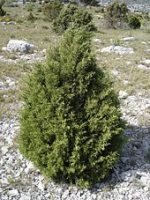
Also known as Arar this evergreen shrub or small tree grows on sandy or rocky ground throughout the Mediterranean area including Lebanon, Palestine, and western Saudi Arabia near the Red Sea. It is a member of the cypress family, Cupressaceae, that also includes arborvitae and redwood. Plants grow 7-40′ tall and have a shallow root system, grayish-brown exfoliating bark, and a rounded or irregular crown. Juvenile leaves are needle-like and smaller than the scale-like adult leaves. They are green to blue green and arranged in opposite decussate pairs or in whorls of three. Male and female cones usually occur on the same plant but may occur on different plants. The male cones are smaller than the female cones and shed their pollen in spring. The larger, berry-like, female cones are orange-brown sometimes with a pinkish waxy bloom. They ripen 18 months after pollination, contain 3-8 seed, and are dispersed by birds. Photo Credit Wikimedia
The Hebrew words ar-ar and aro-er or aro’air, is usually translated heath but probably did not refer to true heaths as most heaths do not occur in Palestine. Most authorities believe the plant intended was either Phoenician juniper that grows on the west side of the mountains of Edom or eastern prickly juniper ( Juniperus deltoides) which inhabits the most barren and rocky parts of the desert .
Jeremiah 17:6 (KJV) The prophet decries anyone who trusts a fallible man.
“For he shall be like the heath in the desert, and shall not see when good cometh; but shall inhabit the parched places in the wilderness, in a salt land and not inhabited.”
Jeremiah 48:6 (KJV) The prophet warns of the impending judgement against the cities of Moab.
“Flee, save your lives, and be like the heath in the wilderness.”
Phoenician juniper likes full sun and a hot, arid climate with a moderately basic soil in USDA Hardiness Zones 7-10. It is very drought tolerant and so is a good possibility for xeriscaping. Plants are generally healthy and need little care. Propagation is by seed.
The genus name, Juniperus, is the ancient Latin name for the plant. The specific epithet, phoenicia, honors ancient Phoenicia, where the plant was believed native.